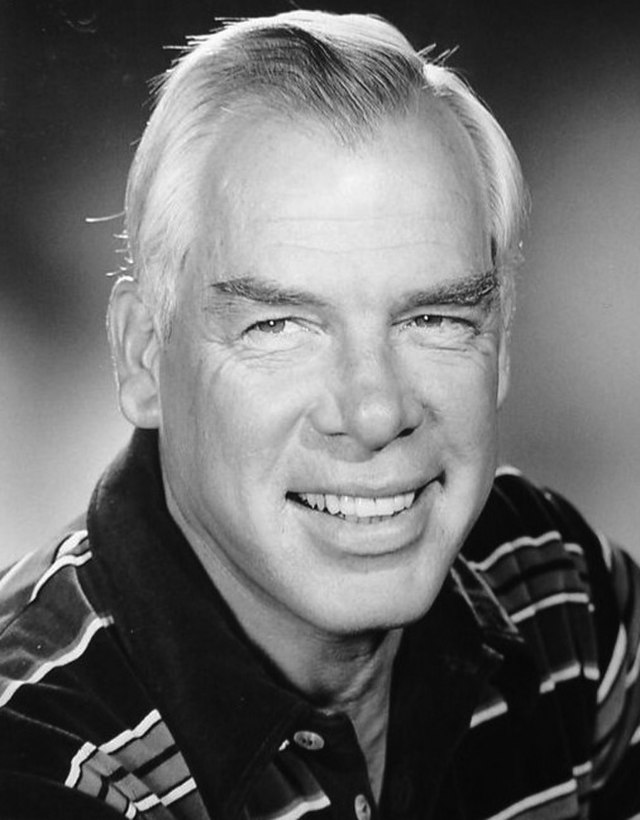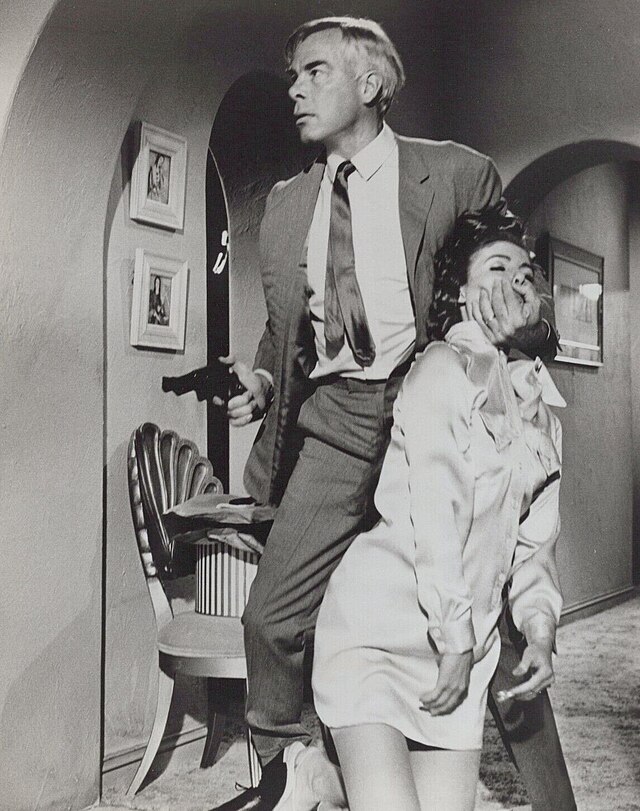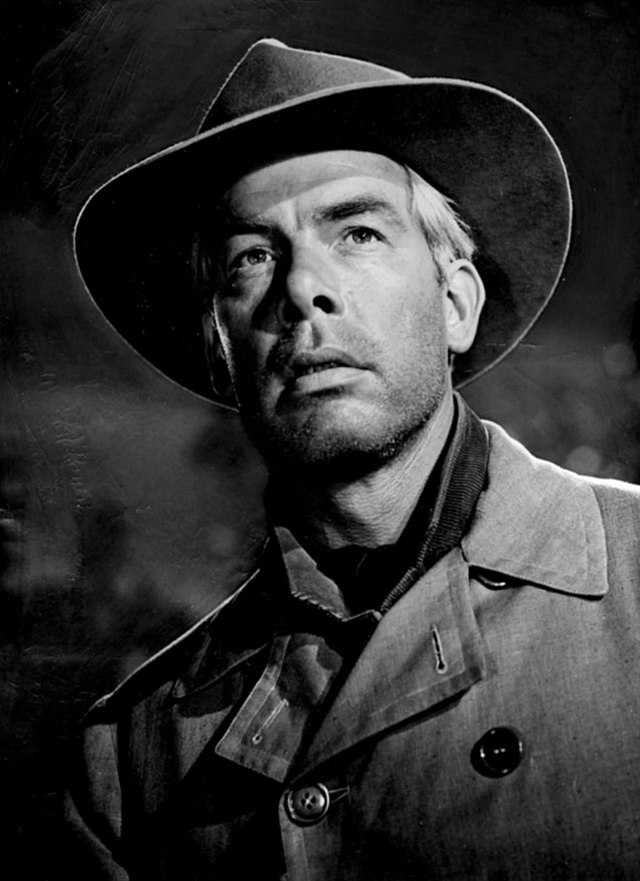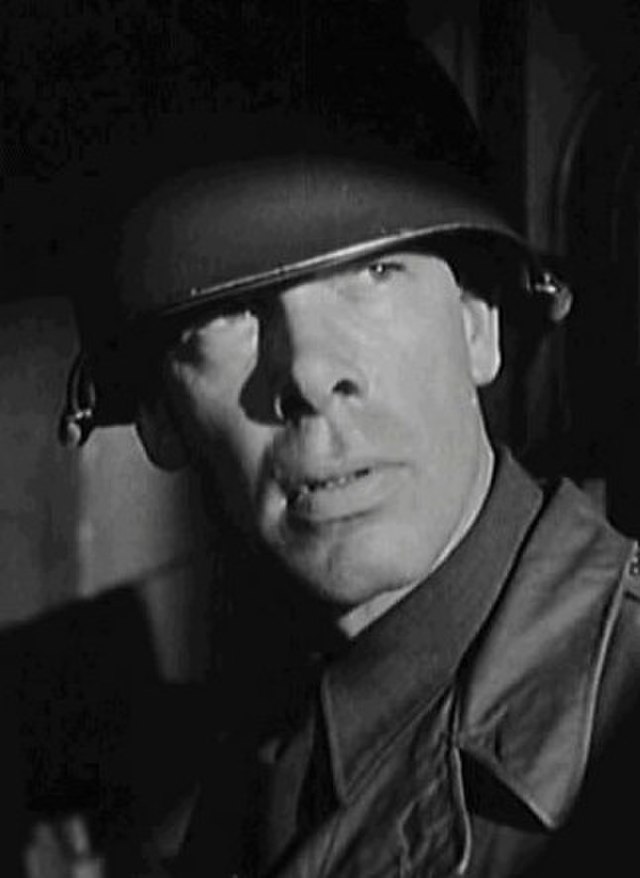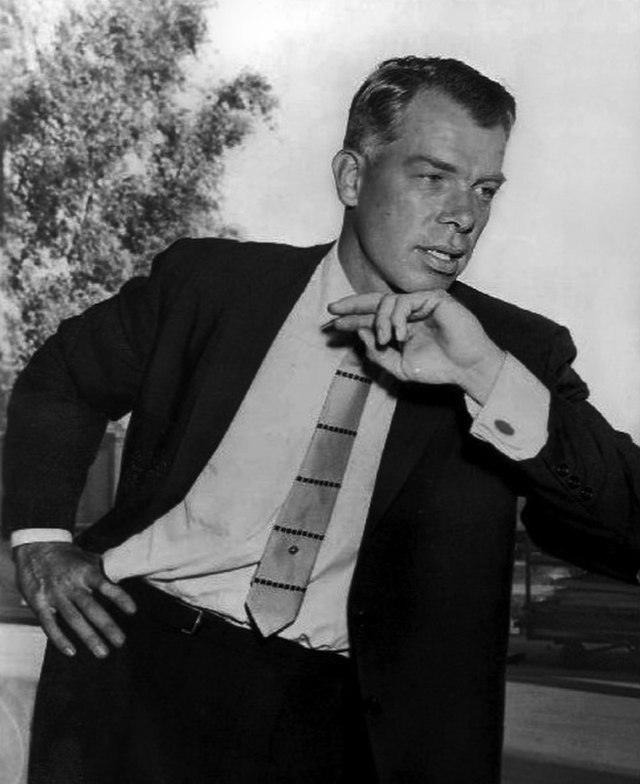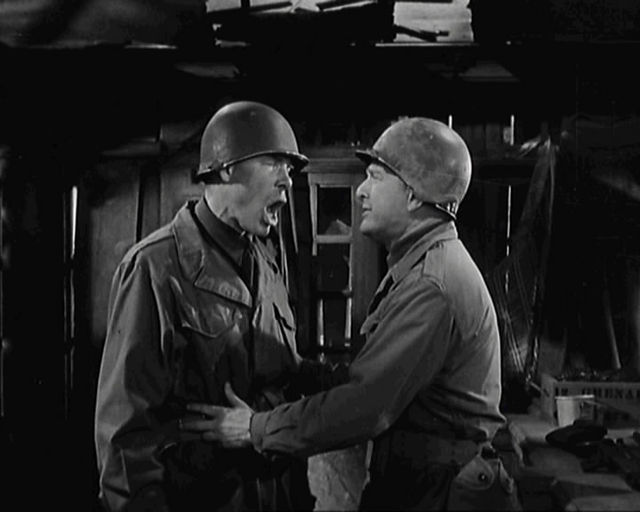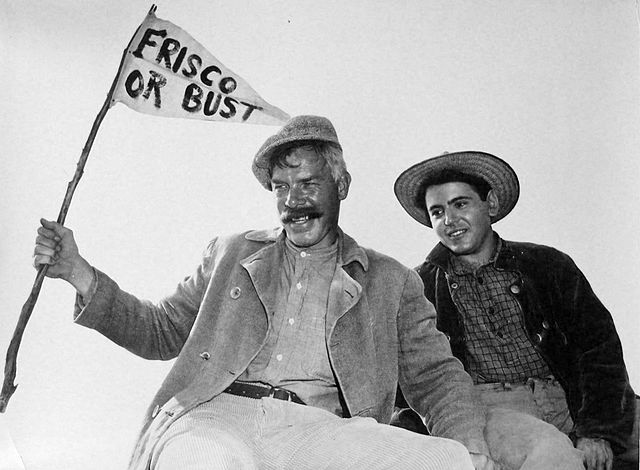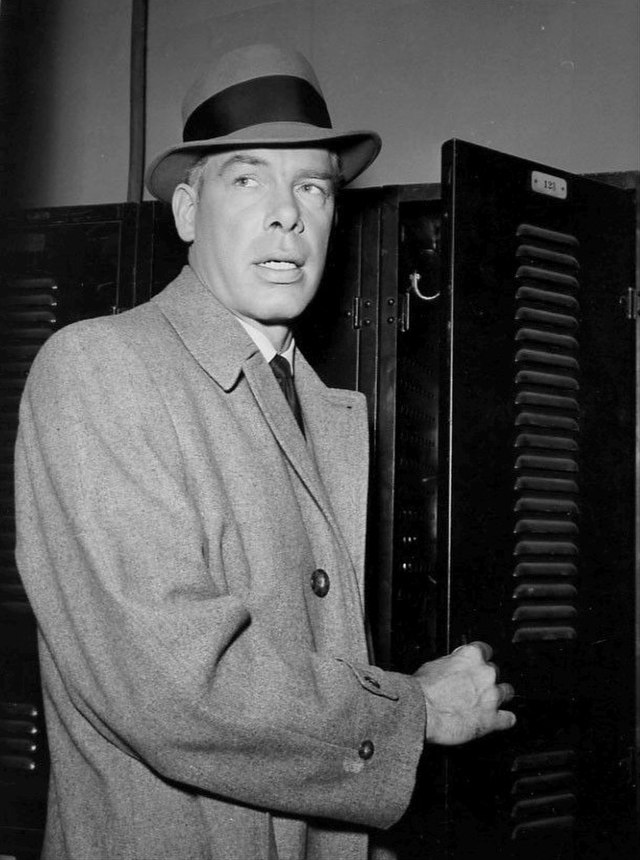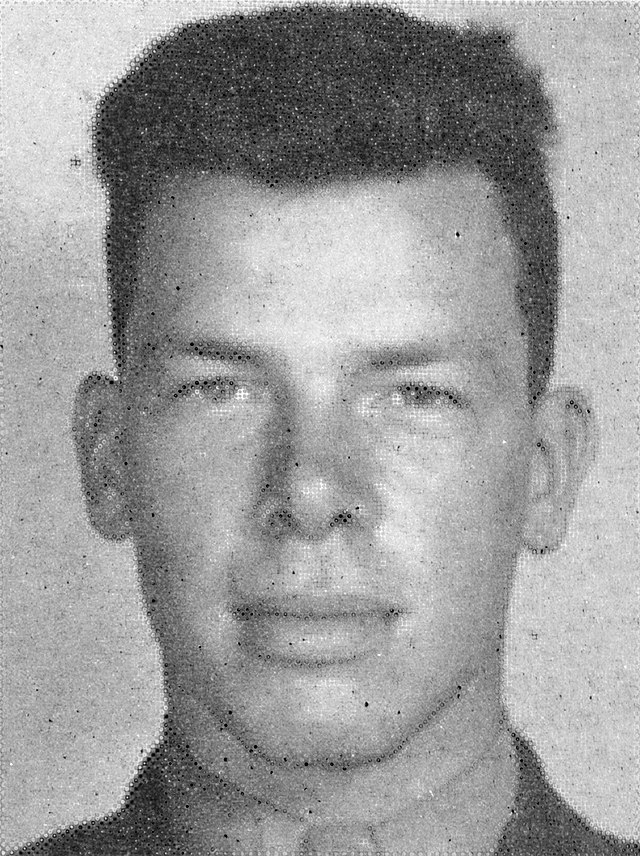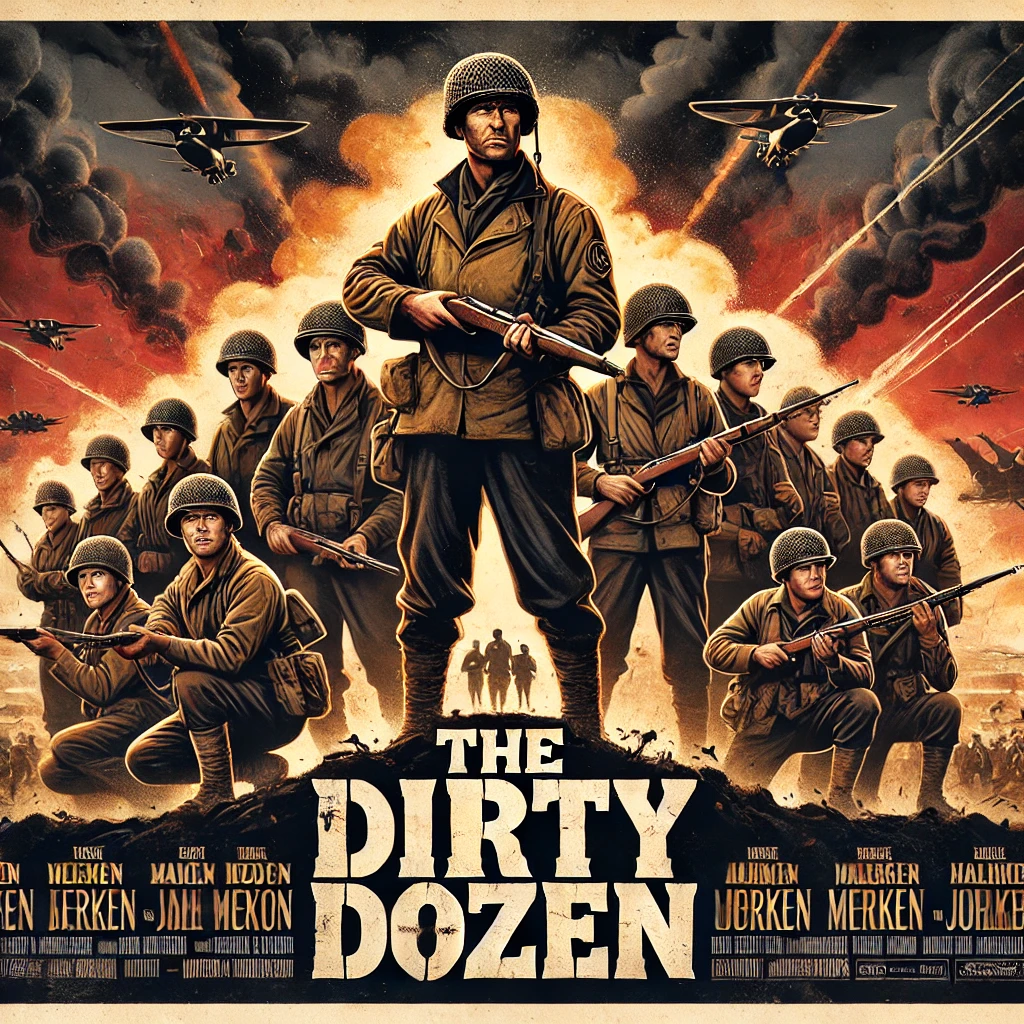Lee Marvin (1924 – 1987)
Biography and Movie Career
Early Life and Military Service
Lamont Waltman Marvin Jr., known to the world as Lee Marvin, was born on February 19, 1924, in New York City. He was the son of Lamont Waltman Marvin Sr., an advertising executive, and Courtenay Washington, who had roots tracing back to George Washington’s family. Raised in a well-to-do household, young Lee grew up in various locations, including New York, Florida, and Connecticut, and attended prestigious schools such as Manumit School in Pennsylvania and St. Leo College Preparatory School in Florida.
Despite his privileged upbringing, Marvin was a rebellious and independent spirit, often getting into trouble at school. His academic career was unremarkable, and he had little interest in following a conventional path. However, the outbreak of World War II gave his life a new direction.
In 1942, at the age of 18, Marvin enlisted in the United States Marine Corps, serving as a scout sniper with the 4th Marine Division. He saw intense combat in the Pacific Theater, particularly in the Battle of Saipan, where he was seriously wounded in the buttocks and leg by machine-gun fire. This injury ended his military service, and he was honorably discharged as a Private First Class. For his bravery, he was awarded the Purple Heart, among other decorations.
The Road to Hollywood
After returning to the United States, Marvin struggled to find his footing. He took on various jobs, including plumbing, before an unexpected opportunity changed his life. While working as a plumber’s assistant at a local community theater in upstate New York, he was asked to step in for an actor who had fallen ill. This seemingly small moment ignited his passion for acting.
Marvin moved to New York City and began studying at the American Theatre Wing, honing his craft in Off-Broadway productions. He worked his way up in the New York theater scene, gaining experience and recognition. His commanding presence, deep voice, and intense gaze made him stand out, leading to offers in film and television.
By the early 1950s, Marvin relocated to Hollywood, where he was quickly cast in tough-guy roles, often portraying villains and military men. His first notable roles were in films such as The Big Heat (1953), where he played a sadistic gangster, and The Wild One (1953), opposite Marlon Brando.
Breakthrough and Hollywood Stardom
Though he built a strong career as a character actor, it wasn’t until the 1960s that Lee Marvin became a leading man. His breakout role came in John Ford’s The Man Who Shot Liberty Valance (1962), where he played the ruthless outlaw Liberty Valance, solidifying his status as a top-tier villain in Hollywood.
In 1965, Marvin took on a rare dual role in the comedy-western Cat Ballou, playing both the washed-up gunfighter Kid Shelleen and his evil twin, Tim Strawn. His performance was both hilarious and layered, winning him the Academy Award for Best Actor.
Following this, he starred in a string of box office hits, including:
• The Professionals (1966)
• The Dirty Dozen (1967) – One of his most famous roles
• Point Blank (1967) – A neo-noir classic that showcased his acting depth
• Hell in the Pacific (1968) – A unique war film where he starred opposite Toshiro Mifune
Throughout the 1970s and early 1980s, Marvin continued to take on tough, no-nonsense roles in films like Monte Walsh (1970), Emperor of the North (1973), and The Delta Force (1986), his final major film.
Personal Life and Marriages
Lee Marvin’s personal life was just as colorful as his on-screen roles. He was married twice:
• First marriage: In 1951, he married Betty Ebeling. The couple had four children—Christopher, Courtenay, Cynthia, and Claudia—but their marriage ended in divorce in 1967.
• Second marriage: In 1970, he married Pamela Feeley, his childhood sweetheart, and they remained together until his death.
One of the most controversial aspects of Marvin’s personal life was the palimony lawsuit brought against him in 1979 by Michelle Triola, a woman he had lived with for several years. She sued him for financial support, claiming they had lived as husband and wife even though they were not legally married. The case, Marvin v. Marvin, became a landmark legal battle, bringing the concept of palimony into the public eye. Though Triola initially won a settlement, the ruling was later overturned.
Passions and Interests
Beyond acting, Lee Marvin had a deep love for fishing, sailing, and the outdoors. He was an avid sportsman and often retreated to his home in Tucson, Arizona, where he found solace away from Hollywood.
He also remained deeply connected to his military roots, often speaking about his wartime experiences. Unlike many actors who simply played soldiers on screen, Marvin had lived through real combat, and this authenticity came through in his performances.
Final Years and Death
By the mid-1980s, Marvin’s health began to decline. Years of heavy drinking and smoking had taken a toll on his body. In 1986, he underwent intestinal surgery, which led to complications. His condition worsened over the following months, and on August 29, 1987, he passed away at the age of 63 due to a heart attack in Tucson, Arizona.
He was laid to rest with full military honors at Arlington National Cemetery, an honor befitting a decorated veteran.
Legacy
Lee Marvin left behind an unforgettable mark on Hollywood. His gritty realism, commanding presence, and no-nonsense style made him one of the greatest tough-guy actors of his generation. Whether playing heroes, antiheroes, or outright villains, he brought a unique authenticity to every role.
His influence can be seen in later actors who embodied similar personas, such as Clint Eastwood and Charles Bronson. To this day, his performances remain iconic, and his impact on film and television endures.
Lee Marvin’s Measurements and Physical Features
• Height: 6 feet 2 inches (1.88 m)
• Weight: Approximately 190–200 lbs (86–91 kg) during his prime
• Hair Color: Silver/Gray (prematurely gray by his early 30s)
• Eye Color: Blue
• Build: Athletic, lean but muscular
• Distinctive Features:
o Deep, gravelly voice
o Chiseled, rugged facial structure with high cheekbones and a square jaw
o Steely, piercing blue eyes that added to his intense on-screen presence
o Weathered, lined face, giving him a naturally tough and lived-in look
o Confident, purposeful walk with a slight slouch, adding to his effortless toughness
Lee Marvin on Tonight Show with Johnny Carson
Lee Marvin’s Acting Style: A Gritty, Uncompromising Force of Nature
Lee Marvin was one of Hollywood’s most distinctive actors, embodying gritty realism, raw masculinity, and quiet intensity in a way few others could. His performances were often understated yet deeply powerful, characterized by an economy of movement, a commanding presence, and an ability to project both menace and vulnerability.
Minimalism with Maximum Impact
Marvin was a master of understatement. He never wasted words or gestures; instead, he let silence and body language do much of the work. His deep, gravelly voice was used sparingly, often punctuating scenes with sharp, clipped dialogue rather than elaborate monologues. This economical approach to acting made his characters feel authentic and dangerous—a man of few words always seemed far more unpredictable than one who talked too much
.
In films like Point Blank (1967), Marvin’s Walker is almost a ghost, stalking his betrayers with mechanical precision, speaking only when necessary. His physicality and stillness become more terrifying than any shouted threats. This minimalist approach created a unique, almost hypnotic screen presence.
A Physically Commanding Presence
Standing at 6'2", Marvin had a towering, muscular frame that he used effectively. Whether playing a soldier, outlaw, or criminal, his sheer physicality made him a force to be reckoned with. But unlike other tough-guy actors of his era, he didn’t rely on exaggerated movements or showy displays of strength. Instead, he carried himself with a natural toughness—a man who had been through real battles (both on and off the screen) and didn’t need to prove anything.
His military background infused his performances with authenticity. He moved like a man who had been trained to fight, to kill, and, most importantly, to survive. In war films like The Dirty Dozen (1967) and Hell in the Pacific (1968), he carried himself with the hardened confidence of someone who had actually been in combat.
A Unique Blend of Ruggedness and Vulnerability
What set Marvin apart from many of his contemporaries was his ability to blend toughness with unexpected tenderness or introspection. He wasn’t just a one-note tough guy—his characters often carried a sense of melancholy, exhaustion, or disillusionment, giving them depth and realism.
In Monte Walsh (1970), he plays an aging cowboy struggling to adapt to the changing world. Unlike the fearless gunslingers of classic westerns, Monte is a man aware of his own mortality and irrelevance. Marvin conveys this with subtle expressions, a weary posture, and an almost resigned acceptance that the world has moved on without him.
Even in The Killers (1964), where he plays a ruthless hitman, there’s a cold professionalism rather than sadistic glee. He doesn’t kill because he enjoys it—he does it because it’s his job. That detachment made him even more chilling
.
The Anti-Hero Before It Became Popular
Marvin frequently played anti-heroes, long before the trend took off in Hollywood. He could be morally ambiguous, violent, even cruel, but he never felt like a villain in the traditional sense. Instead, he played men shaped by harsh environments, betrayed by their past, or simply trying to survive in a brutal world.
In The Professionals (1966), his character is a hired mercenary, a man who kills for money. But he operates by his own code of honor, and that inner morality makes him more than just a thug.
His portrayal of Liberty Valance in The Man Who Shot Liberty Valance (1962) is an exception—one of his few pure villain roles. As Valance, he revels in cruelty, playing a lawless brute who enjoys tormenting the weak. Yet even here, Marvin avoids caricature; his Valance is terrifying because he feels authentically unhinged, not like a comic-book villain.
Comic Timing and Self-Awareness
Despite his rugged, violent roles, Marvin had a surprising gift for comedy, particularly in Cat Ballou (1965). His dual performance as both the bumbling, drunken Kid Shelleen and his ruthless doppelgänger Tim Strawn showed that he didn’t take himself too seriously. His comedic timing was dry and effortless, playing off his usual tough-guy persona to create moments of hilarious absurdity.
His willingness to poke fun at his own image gave him even more depth as an actor. He wasn’t just a hard-edged action star; he was an intelligent performer who understood the nuances of storytelling and character.
A Legacy of Unfiltered Authenticity
Lee Marvin’s acting style can be best summed up as unfiltered authenticity. He never seemed like he was "acting"—he simply was the character. Whether playing a hardened soldier, a weary cowboy, or a remorseless killer, he brought a realism and gravity to every role.
His performances remain timeless because he never relied on theatrical excess. Instead, he found the power in silence, restraint, and raw physicality, making him one of the most unique and underrated legends of classic Hollywood.
Memorable Quotes by Lee Marvin
Lee Marvin was known for his blunt, no-nonsense attitude both on and off screen. His quotes reflect his tough-guy persona, dry humor, and deep understanding of his craft. Here are some of his most memorable lines:
________________________________________
On Acting and Hollywood
• "You can't work three or four months in a picture and not be influenced by it. I'm sure it has changed me in some small way."
• "There’s no way to fake a performance. You’ve got to be honest. You just can’t act."
• "I love Westerns. They're a way of seeing how a country grows and how people grow with it."
• "I only make movies to finance my fishing."
• "The difference between a good shot and a bad shot is the sound of the director yelling ‘Action!’"
________________________________________
On His Tough-Guy Image
• "I have been getting away with it for 50 years. I don't do anything. I just let the camera record it."
• "I am not a tough guy, but I portray tough guys."
• "Hero or villain, I’d rather be mean than weak."
________________________________________
On War and His Military Service
• "As a Marine in the war, I saw men killed. I saw men burned. Half my foot was ripped off. I was in pain for 20 years after that."
• "In war, you get killed for taking a risk. In Hollywood, you get killed for not taking one."
________________________________________
On His Famous Roles
• "Kid Shelleen is probably the only comic character I ever played in my career, and it won me an Oscar!" (Cat Ballou, 1965)
• "I was Liberty Valance, the meanest man who ever lived. I was so mean I shot my own horse!" (The Man Who Shot Liberty Valance, 1962)
• "The Dirty Dozen was one of the best times I ever had in my life. And if you can't have a good time making a movie with Charles Bronson, Jim Brown, John Cassavetes, and Telly Savalas, then you don’t belong in the business." (The Dirty Dozen, 1967)
________________________________________
On Life and Philosophy
• "If your house burns down, just walk away. That’s what they’re for."
• "I live with my cat, who is my best friend. What else do I need?"
• "We all wind up dead, it’s just a question of how and when."
What Others Said About Lee Marvin
Lee Marvin was admired and respected by fellow actors, directors, and critics for his authenticity, rugged charisma, and intense screen presence. He left a lasting impact on Hollywood, and many of his colleagues shared their thoughts about him over the years.
________________________________________
Fellow Actors on Lee Marvin
Clint Eastwood (Actor, Director)
• "Lee had a way of taking a role and making it his own. He didn’t just act tough—he was tough. But he was also incredibly intelligent about his performances, always knowing when to hold back and when to explode."
Eastwood admired Marvin’s control and subtlety, traits that influenced his own acting style.
John Wayne (Co-Star in The Comancheros and Donovan’s Reef)
• "He was a hell of an actor. He could play a mean son of a bitch, and then turn around and make you laugh your ass off in the next scene. That’s rare."
Wayne praised Marvin’s versatility, from playing villains (Liberty Valance) to comedic roles (Cat Ballou).
Robert Ryan (Co-Star in The Dirty Dozen)
• "Lee was the real deal. He didn’t have to prove he was tough. You just knew it. But beneath that, there was a depth to him that a lot of people didn’t see."
Ryan highlighted Marvin’s genuine toughness but also his emotional depth.
Burt Lancaster (Co-Star in The Professionals)
• "He could steal a scene with a glance or a grunt. And that’s a rare gift."
Lancaster acknowledged Marvin’s ability to command attention with minimal effort.
Charles Bronson (Co-Star in The Dirty Dozen and Death Hunt)
• "Lee didn’t play characters. He lived them."
Bronson, another Hollywood tough guy, appreciated Marvin’s authenticity in his roles.
Ernest Borgnine (Co-Star in Emperor of the North)
• "Lee was one of the best I ever worked with. He didn’t take himself too seriously, but when the cameras rolled, he was all business."
Borgnine noted Marvin’s professionalism and ability to balance work and fun.
________________________________________
Directors on Lee Marvin
John Boorman (Director of Point Blank)
• "Lee Marvin had a presence that was impossible to ignore. He was like a force of nature—controlled, precise, and deeply intimidating on screen."
Boorman worked closely with Marvin in Point Blank, a film that showcased his icy, relentless persona.
Robert Aldrich (Director of The Dirty Dozen)
• "Marvin wasn’t just an actor—he was a warrior. He brought his own life experience into every role, and that made all the difference."
Aldrich saw Marvin’s combat experience as key to his authenticity in military roles.
Richard Brooks (Director of The Professionals)
• "He could say more with a look than most actors could with an entire speech."
Brooks praised Marvin’s ability to communicate emotion and intent through body language.
________________________________________
Film Critics and Historians on Lee Marvin
Roger Ebert (Film Critic)
• "Lee Marvin had the kind of face and presence that could tell an entire story before he even spoke a word."
Ebert noted that Marvin’s physicality and expressions often conveyed more than dialogue ever could.
Pauline Kael (Film Critic)
• "Marvin brought a raw honesty to every role he played. He wasn’t interested in looking like a hero—he was interested in telling the truth."
Kael respected Marvin’s commitment to realism, even when playing antiheroes or villains.
David Thomson (Film Historian)
• "If ever there was an actor who could embody both the brutality and the tragedy of the American tough guy, it was Lee Marvin."
Thomson saw Marvin as the ultimate embodiment of rugged masculinity with an underlying sadness.
________________________________________
Military Veterans on Lee Marvin
Many veterans respected Marvin for his real-life military service. Unlike many actors who only portrayed soldiers on screen, Marvin had actually served in combat during World War II and was wounded in action.
• "Lee Marvin wasn’t playing a soldier—he was a soldier. You could see it in his eyes." – A Marine Corps veteran who served in the Pacific.
• "He never glorified war in his performances. He showed the exhaustion, the weight of it. That’s why we respected him." – A Vietnam War veteran.
Lee Marvin and James Coburn: A Friendship Forged in Hollywood Toughness
Lee Marvin and James Coburn were close friends and contemporaries, both known for their rugged, charismatic on-screen personas and love for Western and action films. Their careers often ran parallel, with each carving out a niche as Hollywood's go-to tough guys, yet they shared a deep mutual respect and camaraderie off-screen.
________________________________________
Similarities Between Marvin and Coburn
• Both were Hollywood “tough guys” – Known for their gravelly voices, effortless cool, and no-nonsense attitudes.
• Both had military backgrounds – Marvin served in the U.S. Marines during World War II, while Coburn trained in the Army Reserve.
• Both starred in Westerns and action films – Excelling in films that required a mix of toughness and charisma.
• Both were part of Hollywood’s hard-drinking, fun-loving crowd – Alongside actors like Steve McQueen and Robert Mitchum.
________________________________________
Films They Starred in Together
"The Magnificent Seven" (1960) – Almost Co-Stars
• Marvin was originally considered for the role of Britt, the knife-throwing gunslinger, but he turned it down.
• The role went to James Coburn, who became famous for it.
• This film helped establish Coburn as a star, much in the way that The Dirty Dozen (1967) later did for Marvin.
"The Great Escape" (1963) – Marvin Was Considered
• Marvin was initially considered for a role, but it ultimately went to other actors, including Coburn, Steve McQueen, and Charles Bronson.
"Death Hunt" (1981) – Their Only Film Together
• Finally, in 1981, Marvin and Coburn officially co-starred in Death Hunt.
• Marvin played RCMP Sgt. Edgar Millen, a Canadian Mountie hunting down Charles Bronson’s character.
• Coburn played Sundog, Marvin’s partner in the manhunt.
• The film was a gritty, action-packed thriller set in the Yukon wilderness, perfect for both actors.
________________________________________
Their Off-Screen Friendship
• Marvin and Coburn frequently socialized, drinking and sharing stories about Hollywood’s golden age.
• They had a mutual respect for each other's craft, often being compared for their effortless, tough-guy personas.
• Coburn once referred to Marvin as "the real deal," noting that his military experience gave him an authenticity few actors had.
• Both actors were known for their rebellious nature, refusing to conform to Hollywood’s typical leading-man image.
Awards and Recognition
Lee Marvin received widespread recognition for his contributions to film and television, particularly for his performances in war films, westerns, and crime dramas. His accolades include an Academy Award, a BAFTA Award, and multiple other honors for his work on screen.
________________________________________
Major Awards Won
Academy Awards (Oscars)
• Best Actor – Cat Ballou (1965)
o Marvin won his only Academy Award for his dual role as the bumbling, drunken Kid Shelleen and his evil twin brother, Tim Strawn. His performance showcased both his comedic timing and his ability to parody his own tough-guy image.
British Academy Film Awards (BAFTA)
• Best Foreign Actor – Cat Ballou (1965)
o The British Academy recognized Marvin’s outstanding comedic and physical performance in Cat Ballou, further cementing his status as a leading man.
Golden Globe Awards
• Best Actor in a Motion Picture – Musical or Comedy – Cat Ballou (1965)
o Marvin’s work in Cat Ballou earned him a Golden Globe, solidifying his place among Hollywood’s most versatile actors.
• Henrietta Award (World Film Favorite – Male) (1967)
o This award, given by the Golden Globes, recognized Marvin as one of the most popular male film stars worldwide.
National Board of Review
• Best Actor – The Professionals (1966) and The Dirty Dozen (1967)
o Marvin was honored for his performances in two of his biggest hits from the 1960s.
Laurel Awards
• Top Male Comedy Performance – Cat Ballou (1965) – Winner
• Top Action Performance – The Professionals (1966) – 2nd place
• Top Action Performance – The Dirty Dozen (1967) – 2nd place
David di Donatello Awards (Italy)
• Best Foreign Actor – Cat Ballou (1965)
o The Italian film industry also recognized Marvin’s performance, showing his broad international appeal.
________________________________________
Nominations and Other Recognitions
Golden Globe Award Nominations
• Best Actor – Drama – Point Blank (1967) – Nominated
• Best Actor – Drama – Paint Your Wagon (1969) – Nominated
Primetime Emmy Awards
• Outstanding Lead Actor in a Miniseries or Special – The Snow Goose (1971) – Nominated
Other Honors and Legacy
• Hollywood Walk of Fame
o Marvin was awarded a star on the Hollywood Walk of Fame for his contributions to the film industry. His star is located at 6902 Hollywood Boulevard.
• Purple Heart and Military Honors
o Before his acting career, Marvin was a decorated U.S. Marine who received the Purple Heart for his injuries during World War II. His service added an air of authenticity to his many military roles.
• Arlington National Cemetery Burial
o In recognition of both his military service and cinematic legacy, Marvin was buried with full military honors at Arlington National Cemetery, a rare honor for a Hollywood actor.
Movies Starring Lee Marvin
1951:
• "You're in the Navy Now": Marvin's film debut as a radioman in this comedy about the trials of a newly commissioned Navy officer.
• "Teresa": A drama where Marvin plays a minor role in the story of an American soldier who marries an Italian woman during World War II.
1952:
• "Diplomatic Courier": Marvin appears as an MP in this Cold War thriller about a courier tasked with delivering a vital message.
• "We're Not Married!": A comedy featuring Marvin in a small role, revolving around couples who discover their marriages are invalid.
• "The Duel at Silver Creek": A Western where Marvin plays Tinhorn Burgess, involved in a plot about a marshal and a gambler teaming up to fight claim jumpers.
• "Hangman's Knot": Marvin portrays Rolph Bainter in this post-Civil War Western about Confederate soldiers unaware the war has ended.
• "Eight Iron Men": A war film with Marvin as Sgt. Joe Mooney, focusing on soldiers trying to rescue a comrade trapped by enemy fire.
1953:
• "Down Among the Sheltering Palms": A musical comedy with Marvin as Pvt. Shaughnessy, set on a Pacific island during World War II.
• "Seminole": Marvin plays Sgt. Magruder in this Western about conflicts between the U.S. Army and the Seminole tribe.
• "The Glory Brigade": A Korean War film featuring Marvin as Cpl. Bowman, highlighting a Greek-American unit's experiences.
• "The Stranger Wore a Gun": A 3D Western with Marvin as Dan Kurth, involving a former spy seeking a new life in Arizona.
• "The Big Heat": Marvin portrays the sadistic thug Vince Stone in this film noir about a cop investigating his wife’s death.
• "Gun Fury": A Western where Marvin plays Blinky, part of a gang that kidnaps a woman, leading to a vengeful pursuit.
• "The Wild One": Marvin is Chino, the leader of a rival biker gang, in this iconic film about rebellious motorcycle gangs.
1954:
• "Gorilla at Large": A mystery thriller with Marvin as a police officer investigating murders at a carnival.
• "The Caine Mutiny": Marvin plays "Meatball" in this naval drama about a mutiny aboard a U.S. Navy destroyer-minesweeper.
• "The Raid": A historical war film featuring Marvin as Lt. Keating, focusing on Confederate soldiers escaping to Canada to plot a raid.
1955:
• "Bad Day at Black Rock": Marvin is Hector David in this suspenseful tale of a stranger uncovering dark secrets in a small town.
• "Violent Saturday": A crime drama with Marvin as Dill, a bank robber involved in a heist that goes wrong.
• "Not as a Stranger": Marvin plays Brundage in this medical drama about the personal and professional lives of doctors.
• "A Life in the Balance": A thriller featuring Marvin as a serial killer pursued by a young boy and his mother.
• "Pete Kelly's Blues": Marvin portrays Al Gannaway in this musical crime film set in the 1920s jazz scene.
• "I Died a Thousand Times": A crime film with Marvin as Babe Kossuck, part of a gang planning a mountain resort heist.
• "Shack Out on 101": Marvin plays Slob, a short-order cook involved in espionage in this Cold War drama.
1956:
• "Seven Men from Now": A Western featuring Marvin as Bill Masters, a gunman entangled in a revenge plot.
• "Attack": Marvin portrays Lt. Col. Clyde Bartlett in this war drama about a National Guard unit during World War II.
• "Pillars of the Sky": A Western with Marvin as Sgt. Lloyd Carracart, focusing on conflicts between the U.S. Cavalry and Native Americans.
• "The Rack": Marvin plays Capt. John R. Miller in this courtroom drama about a soldier facing court-martial for collaboration.
1957:
• "Raintree County": Marvin is Orville "Flash" Perkins in this Civil War-era romance exploring themes of love and obsession.
1958:
• "The Missouri Traveler": Marvin portrays Tobias Brown in this coming-of-age story about a young drifter finding a home in a small town.
1961:
• "The Comancheros": Marvin plays Tully Crow, a gunslinger involved in arms smuggling, opposite John Wayne.
1962:
• "The Man Who Shot Liberty Valance": Marvin is the titular Liberty Valance, a ruthless outlaw terrorizing a small town, in this classic Western.
1963:
• "Donovan's Reef": Marvin portrays Thomas Aloysius "Boats" Gilhooley in this comedy about expatriates living on a South Pacific island.
1964:
• "The Killers": Marvin plays Charlie Strom, a hitman seeking answers about his latest target, in this crime thriller.
1965:
• "Cat Ballou" – Lee Marvin won an Academy Award for Best Actor for his dual role as both the washed-up drunk gunslinger Kid Shelleen and his evil twin brother, Tim Strawn. This comedy-western follows a young woman seeking revenge for her father's murder.
1966:
• "The Professionals" – Marvin stars as Henry 'Rico' Fardan, the leader of a group of mercenaries hired to rescue a kidnapped woman in Mexico. This action-packed western is known for its sharp dialogue and dynamic performances.
1967:
• "The Dirty Dozen" – One of Marvin's most famous roles, he plays Major John Reisman, an unorthodox military officer assigned to lead a group of condemned criminals on a near-suicidal mission behind enemy lines during World War II.
• "Point Blank" – A neo-noir thriller where Marvin plays Walker, a man betrayed and left for dead who seeks vengeance and his stolen money. The film became a cult classic for its innovative storytelling and hard-boiled aesthetic.
1968:
• "Hell in the Pacific" – Marvin and Japanese star Toshiro Mifune portray two World War II soldiers, one American and one Japanese, stranded on an island. Despite their differences, they must cooperate to survive.
1969:
• "Paint Your Wagon" – A musical western where Marvin co-stars with Clint Eastwood and Jean Seberg. He plays Ben Rumson, a hard-drinking prospector who unexpectedly finds himself in a polyamorous relationship during the California Gold Rush.
1970:
• "Monte Walsh" – A revisionist western about an aging cowboy struggling to adapt to the changing times as the Old West fades away. Marvin delivers a poignant performance as a man out of place in a modernizing world.
1972:
• "Pocket Money" – A buddy film where Marvin plays Leonard, a grizzled cowboy who partners with Paul Newman’s character in a shady cattle-smuggling deal.
1973:
• "Emperor of the North" – A gritty Depression-era film in which Marvin plays A-No.1, a legendary hobo who takes on a brutal railroad enforcer (played by Ernest Borgnine) in a battle of wits and survival.
1974:
• "The Spikes Gang" – A western adventure where Marvin plays an aging outlaw mentoring three young men who aspire to be bandits, only to learn the harsh realities of an outlaw’s life.
1976:
• "The Great Scout & Cathouse Thursday" – A comedic western where Marvin portrays Sam Longwood, a former gold prospector seeking revenge against a conman who swindled him years ago.
1979:
• "Avalanche Express" – A Cold War thriller with Marvin as a U.S. agent attempting to help a high-ranking Soviet defector escape aboard a train while evading assassination attempts.
1980:
• "Death Hunt" – Inspired by a true story, Marvin plays a determined Royal Canadian Mounted Police officer hunting down a fugitive (played by Charles Bronson) in the snowy wilderness of the Yukon.
1981:
• "Gorky Park" – A mystery-thriller in which Marvin plays an American businessman involved in a complex web of Soviet intrigue and murder investigations.
1983:
• "Dog Day" – Marvin stars as Jimmy Cobb, a criminal on the run who takes refuge in a farmhouse, leading to tension and psychological drama.
1986:
• "The Delta Force" – Marvin’s final film, co-starring Chuck Norris, where he plays Colonel Nick Alexander, leading an elite counter-terrorism team on a daring mission to rescue hostages from a hijacked plane.

